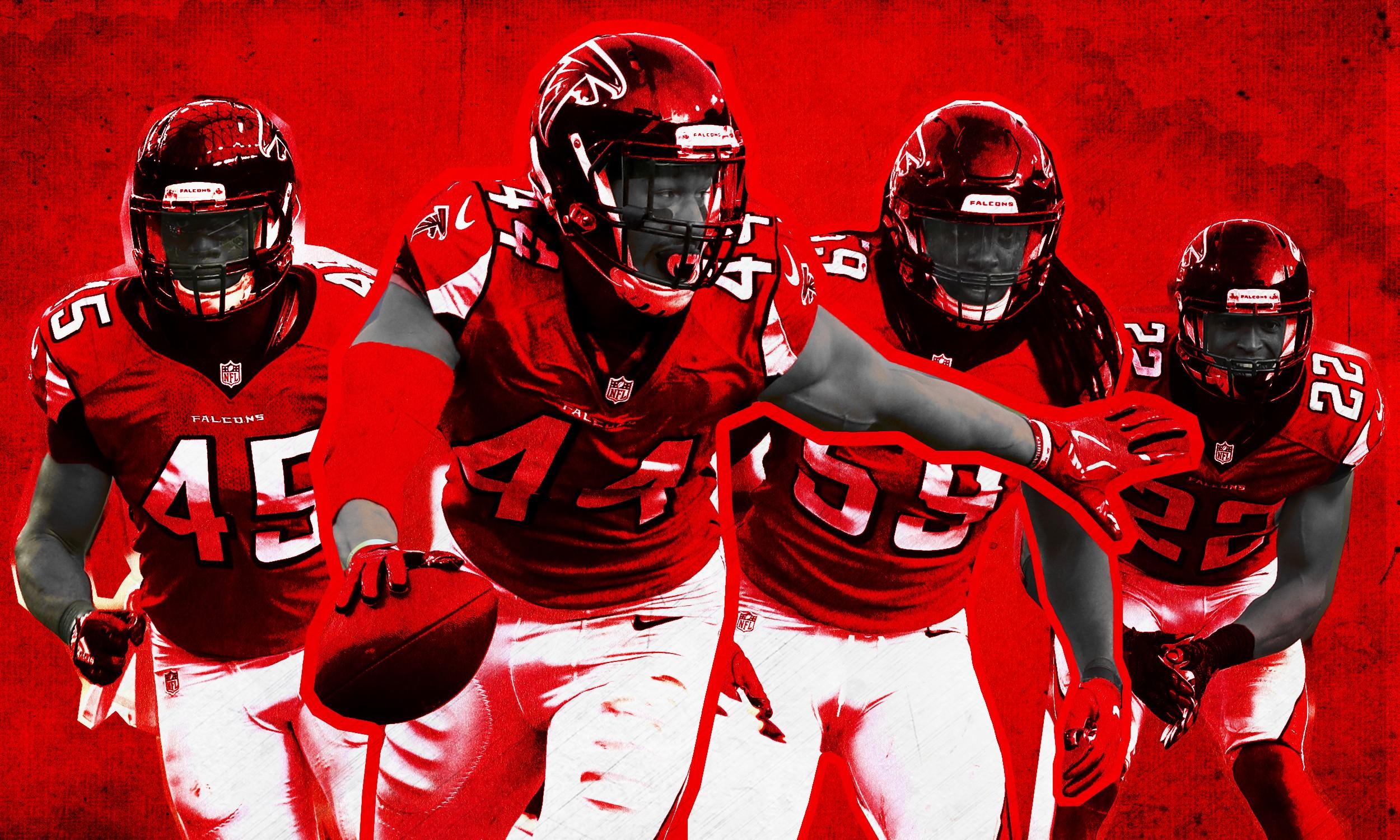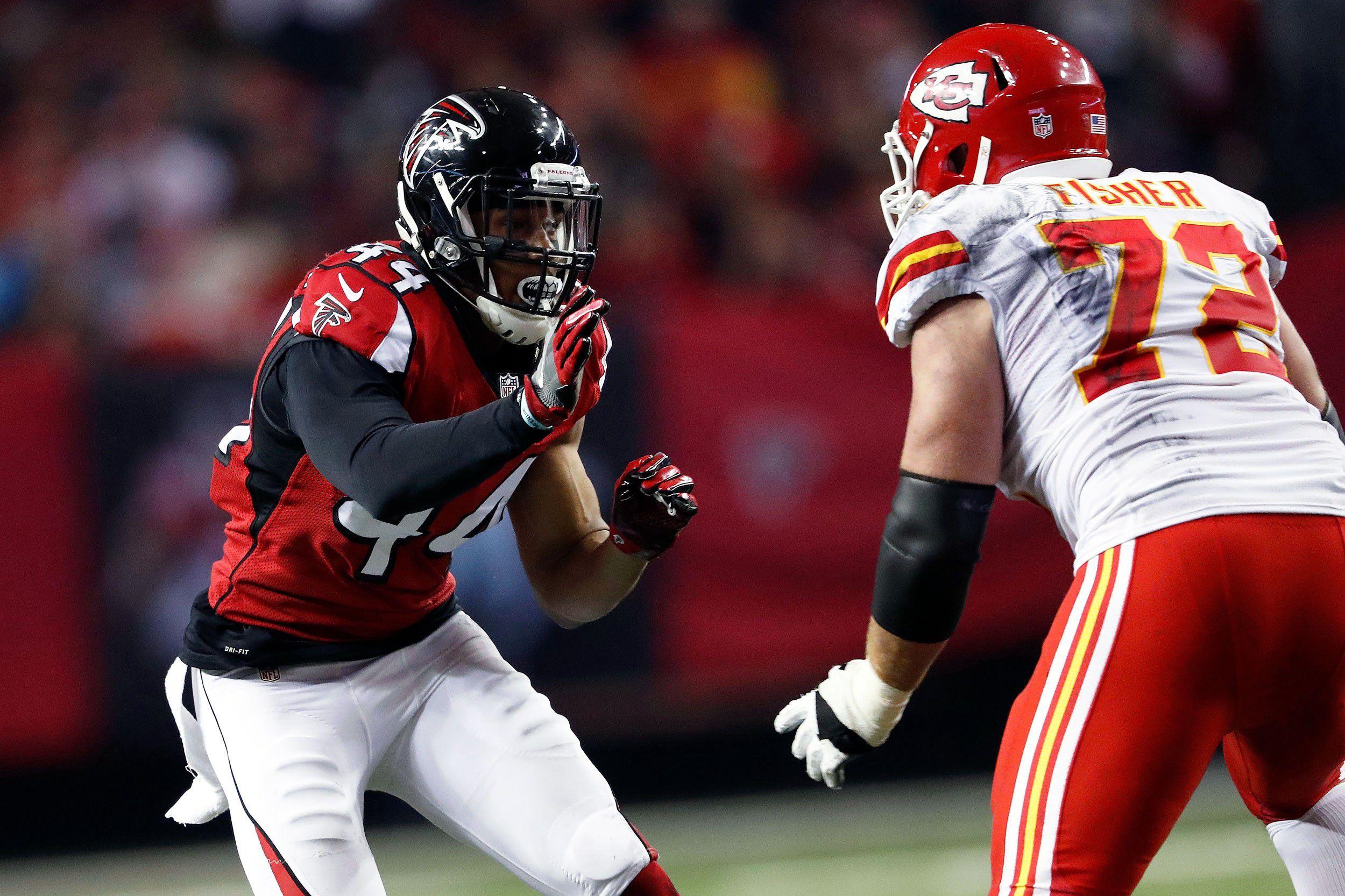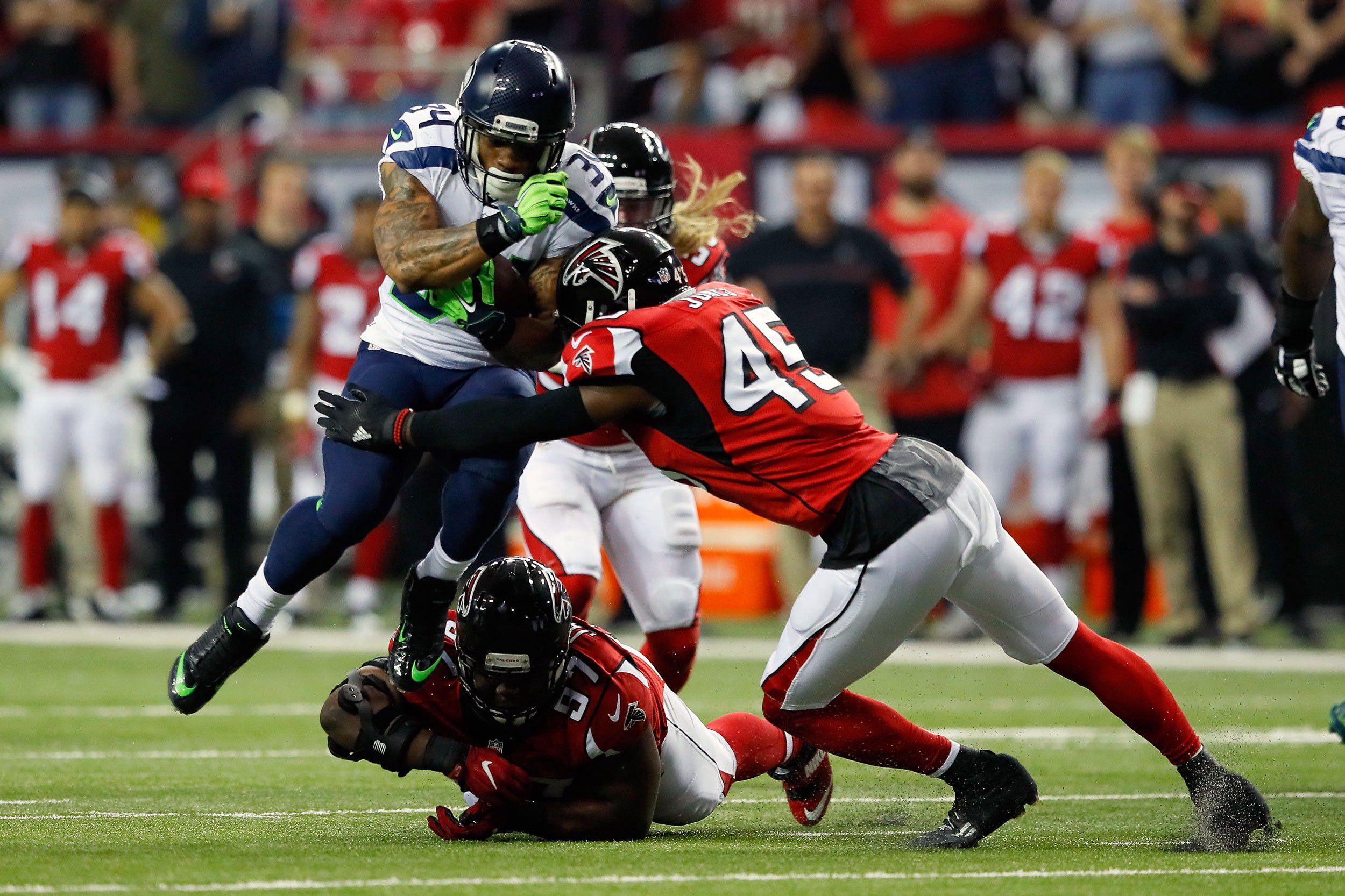
On a February morning in 2015, not long after Dan Quinn was hired as the 16th head coach in Atlanta Falcons history, the team’s scouting staff gathered in the draft room at the team facility in Flowery Branch, Georgia. Quinn’s hiring represented a new beginning, not only for the organization as a whole, but also for general manager Thomas Dimitroff. Dimitroff, then 48, had worked with former Atlanta coach Mike Smith for seven seasons, and a new hire was a chance to consider what he wanted to do differently. From his initial interview with Quinn, Dimitroff says he felt as if he’d found his football soulmate. “When Dan came on, I thought, ‘This is a marriage made in heaven,’” he says from his office overlooking the Falcons practice field.
The pair shared a similar gridiron worldview — that finding exceptional athletes who could cause and negate matchup problems should take precedence over everything else. To ensure that ideology would spread throughout their respective staffs, they decided to hold a daylong symposium — the first of several they’d conduct — during which Quinn and his coaches would present the schemes they planned to implement and the types of players that would best make it work. “In hindsight, as I looked at what we did here before, I didn’t feel like we were as clear on what we needed, the nuances of each position, as we should’ve been,” Dimitroff says. “And Dan completely agreed and we ran with it.”
One by one, Quinn, his coordinators, and the team’s position coaches stepped to the front of the room and delivered pitches on the sorts of players they coveted. As the day wore on, a common theme emerged. “It was Dan, it was the defensive coordinator, it was the secondary coach, it was the linebacker coach, it was the D-line coach — everyone was emphasizing speed, speed, speed,” Dimitroff says. “This was going to be one of the fastest teams that any of us would ever put together.”
In the two years since, nearly all of Atlanta’s personnel moves have fit that philosophy. That began in earnest in the 2015 draft, when the Falcons took Clemson pass rusher Vic Beasley — and his 4.53-second 40-yard dash time — with the eighth overall pick. The approach hasn’t changed. From snapping up players like running back Tevin Coleman (4.39 in the 40; in the 94th percentile at the position) and linebacker Deion Jones (4.59; 83rd) to signing free agents like wide receiver Taylor Gabriel (4.28; math does not compute), the Falcons have hoarded speed at every turn.
On offense, the addition of guys like Coleman and Gabriel have put Atlanta over the top, turning quarterback Matt Ryan’s bunch into an 11-man Death Star averaging an NFL-best 33.8 points per game. On defense, it’s given the Falcons a fighting chance.
There’s still plenty of work to be done on a unit that finished dead last in Football Outsiders’ defensive DVOA in 2014 and 27th in the metric in 2016, but as Dimitroff and Quinn have chased their vision, they’ve assembled a group of young, fast difference-makers who can sway a game with a single play. And to slow down Green Bay’s Aaron Rodgers, a quarterback hurling lightning bolts and performing minor miracles, in Sunday’s NFC title game, the speed lining the Falcons defense may be their greatest hope.

As Quinn and Dimitroff scouted Beasley in the leadup to the 2015 draft, his physical prowess was obvious. The former Clemson star had broken the NFL combine with scores that put him in the upper echelon among defensive ends in nearly every drill. But the pair saw Beasley as more just than a bundle of staggering explosiveness. He was smooth, flexible, always in control. To Dimitroff, he had a combination of traits comparable to some of the league’s most dominant defenders. “Dan and I had a number of conversations — respectfully to Von Miller, who has achieved so much in this league — that Vic had Von Milleresque abilities and movement,” Dimitroff says.

Whereas Miller was a game wrecker from the start, though, racking up 11.5 sacks as a rookie in 2011, Beasley took some time to acclimate to the NFL. Indecisive, inexperienced, and hampered by a torn labrum, he closed out the 2015 season with only four sacks, a nonfactor for a leaky Falcons defense that finished 22nd in DVOA.
Beasley’s disappointing rookie campaign is part of what made this fall’s eruption so astounding. He recorded a league-high 15.5 sacks — smoking tackles, ruining drives, and becoming the Millerlike force that the Falcons envisioned when they drafted him. In trying to pinpoint what made his surge possible, Beasley cites two factors: He’s moving with the confidence and purpose that he lacked in his first season, and he’s learned a thing or two from the guy playing on the other side of Atlanta’s defensive line. “With Dwight [Freeney] coming in, it helped me understand things a lot better,” Beasley says. “I was just taking my time with everything, and it was a struggle with me at first, but the more I saw, the better I came along.”
When the Falcons signed 36-year-old Dwight Freeney in August, they thought he would bring a bit of pop to their pass rush. Freeney ended the season with three sacks, but his impact on defense transcended his production. He’s taken Beasley in, helping a 24-year-old better suited for the X-Men than a football team unlock his enormous stockpile of gifts. “When you’re young, you can have all the ability in the world, physically — fast, quick, strong, blah, blah, blah,” Freeney says. “But you don’t know when to activate that stuff when you actually want to do [a] particular move that makes you more elusive.”
This season, Freeney says, Beasley has come to understand why he’s utilizing certain pass-rush moves, rather than bombarding offensive tackles with an array of options and hoping one works. That newfound assuredness has allowed Beasley to tap into the speed that made him so alluring to Atlanta in the first place.
To get to a quarterback before he passes, most edge rushers take a tight angle that forces them to dip a shoulder to avoid the meaty paws of an offensive lineman. Beasley is so fast that he can line up wide, making his rushes a heavyweight version of a receiver working against a cornerback in the open field. Instead of ripping past a tackle, Beasley is able to juke around him and still close fast enough to finish with a sack.
It’s a feat Beasley accomplished more than anyone in football this season. Against Rodgers and the Packers, though, it’s his other league-leading stat that may give Atlanta its best shot. Beasley forced six fumbles in 2016, most in the NFL, and has shown a knack for knocking the ball loose when he gets into the backfield. Of Beasley’s 15.5 sacks, 12.5 came with the quarterback in the pocket and Beasley in a traditional pass-rushing role. That means half the time that Beasley got a typical sack, he also jarred the ball free.
Starting with Lawrence Taylor, the classic method for a strip-sack has involved a defensive end coming from a quarterback’s blind side and tomahawking the ball loose. Beasley spends nearly all his time charging off the opposite edge, meaning he doesn’t need a passer to raise his arm to leave the ball exposed. He can see it all the way in, offering him a chance to swipe it anytime he gets close. And given how Ryan and Atlanta’s offense have played, turnovers are about more than preventing points. They’re an opportunity to get a scoreboard-exploding unit off the sideline and into the game. “Going after the ball and that mind-set,” Beasley says, “I understand that it puts our offense back on the field.”
The Falcons’ speed on defense seems to always have them flying around the ball. To go with Beasley’s forced fumbles, 2016 first-round pick Keanu Neal added five of his own (most in the NFL among defensive backs), and Jones — selected in the second round of the 2016 draft — is tied for the league lead in passes defensed among linebackers. He’s added three interceptions, two of which he took to the house. “That’s the goal, to tell you the truth,” Jones says of feeling like he’s a touchdown threat anytime he touches the ball. “If I get a pick and I got room, I’m trying to score.” In Atlanta’s last seven games, including its 36–20 divisional-round win over Seattle, it’s forced 13 turnovers — two more than it managed over the first 10 weeks of the regular season. Even if Rodgers and the Packers pile up yardage on Sunday, the Falcons have what it takes to swing the game in a flash.

Ricardo Allen noticed the disparity from the first day of practice. From his perch at the back of the defense, the Falcons free safety has a unique vantage point, and he instantly recognized a change in front of him. “You see a guy coming from the right hash when they’re throwing it to the left flat, you see him outrunning a lot of people, running past people to make those plays,” Allen says. “It was a different speed.”

The guy in question was Jones, who earned a spot as the starting Mike linebacker in Quinn’s defense almost from the moment he set foot in Atlanta. More than any other position, linebacker was the one the staff and the front office felt most needed an injection of speed. In Jones and 2016 fourth-round pick De’Vondre Campbell, the Falcons added two twitchy, distinctly built defenders. “You had two guys that were very fast, two guys that were very athletic, and two guys that were very different in phenotype,” Dimitroff says.
When they get revved up, Campbell (4.58 in the 40) and Jones (4.59) have virtually identical top-end speed, but each gets there in drastically different ways. At 6-foot-1 and 222 pounds, Jones is short for a linebacker, but his stature and burst give him the look of a player who buzzes around the field. Fellow linebacker Paul Worrilow says there are moments in the meeting room when he’ll ask position coach Jeff Ulbrich to rewind the tape just so he can rewatch Jones run down a ballcarrier.
At 6-foot-4 and 232 pounds, Campbell is a towering presence for an off-the-ball player. His massive frame and Mr. Fantastic–like limbs give the illusion that he isn’t hauling ass, but make no mistake — he gets where he’s going in a hurry. “De’Vondre doesn’t look like he’s going as fast,” Allen says, “but he’s killing ground.”
The Falcons targeted two rookies with different styles and shapes by design. With his initial quickness and change-of-direction skills, Jones is an ideal fit for sticking with running backs. With an uncommon build and length for a linebacker, Campbell is a nuisance for hulking tight ends used to bullying shorter defenders. Atlanta’s offense morphed into the most lethal group in football largely because it assembled an arsenal of weapons with varied strengths, allowing coordinator Kyle Shanahan to attack teams in every way imaginable. Atlanta’s goal in building its defense was the same, only inverted. In adding Jones, Campbell, and Neal, the Falcons were trying to protect against any type of matchup or personnel package that could be used against them. “[Jones is] a little bit smaller, I’m a little bit bigger,” Campbell says. “So when it comes to things like matching tight ends or backs, it’s like the perfect combination.”
Worrilow compares Campbell to 6-foot-4 Seahawks standout K.J. Wright, which is fitting given that Quinn has taken most of the principles he used as Seattle’s defensive coordinator and applied them in Atlanta. Allen estimates that the Falcons use a pure zone look on at least 80 percent of their defensive snaps, and while most teams (including the Mike Smith–era Falcons) read the receivers when playing zone — a concept called “matching” — Quinn’s Falcons make their decisions based almost entirely on the quarterback’s eyes. That technique leads to a lot of soft spots in the underneath areas of a defense — the “kill zone,” Atlanta calls it — and means that closing speed and open-field tackling are paramount for any linebacker in Quinn’s system. This season, the Falcons allowed an average of 4.9 yards after the catch, ninth best in the league.
“Because I’m the guy in the back, I have to clean everything up when everything goes bad,” Allen says. “It’s very rare now that things go bad, because there is so much speed.”
As much as Campbell and Jones complement each other on the field, Jones says the bond they’ve formed off it may be even more valuable. They spend time at each other’s houses — usually, Jones jokes, when he runs out of Haribo gummy bears and makes the five-minute drive to Campbell’s place in Buford to raid his stash of Fruit Roll-Ups. On Monday, the linebackers took their girlfriends on a double date to Benihana. Things like that may seem insignificant, but they’ve facilitated a level of comfort and helped each settle into his role. “Little things,” Campbell says, “like alerts on the field, a receiver cuts his split down or backs a lineman, calling it out like, ay, this is what could happen. Just seeing both of us grow on that level.”

As their knowledge of what Quinn wants on his roster has developed, Dimitroff and the scouting staff have taken to calling well-suited players D.Q. guys. In just two years, they’ve added their share. The speed that Quinn, Dimitroff, and coordinator Rich Smith have craved on the defense has arrived. Now, the challenge is unleashing it. “When you have the speed on your team, it takes another level to get the communication part down,” Quinn says. “It’s one thing to be fast. It’s another thing to play fast.”
In Atlanta’s win over the Seahawks last week, the median age of its 11 most-used defenders was 24. Seven of those guys — Beasley, Campbell, Jones, Neal, tackle Grady Jarrett, and cornerbacks Brian Poole and Jalen Collins — are in their first or second seasons in the NFL. The Falcons may wear red and black, but their defense is undeniably green. “You imagine not only this year, but in the years to come, how much better this class can become,” Smith says. “When they first get here, every play is an experience.”
The learning curve has been steep. Atlanta’s overall progression is such that even after losing star cornerback Desmond Trufant to a season-ending shoulder injury in Week 9, the pass defense got better. From Week 1 to Week 9, the Falcons were 23rd in pass defense DVOA; from that point, they were 11th (ending at 19th on the season). Quinn’s belief is that time has transformed Atlanta’s defense to the point that it bears little resemblance to the one Rodgers carved up for 246 passing yards with four touchdowns the day before Halloween.
“We are playing faster now — and that’s why you’ve heard me say we’re a better version of ourselves than we were when we played Green Bay earlier in the season,” Quinn says. “The reason is that our speed hasn’t changed as a player. Our speed has changed as a defense.”
The Falcons still have glaring flaws on this side of the ball (they were dead last in run-defense DVOA over the second half of the season — a byproduct of their smaller, sleeker approach). But in the areas that should matter most against the Packers, they’ve grown by leaps and bounds. With the regular season in the rearview, Quinn’s youthful bunch has begun to match its play speed to its timed speed. If the Falcons have any prayer of slaying the dragon that is Rodgers, it’ll be a product of their commitment to getting fast — in a hurry. “We both believe in the same thing,” Dimitroff says of Quinn. “It’s about getting athletes, it’s about getting speed, it’s about being urgent, fast, explosive. That was our drive.”
